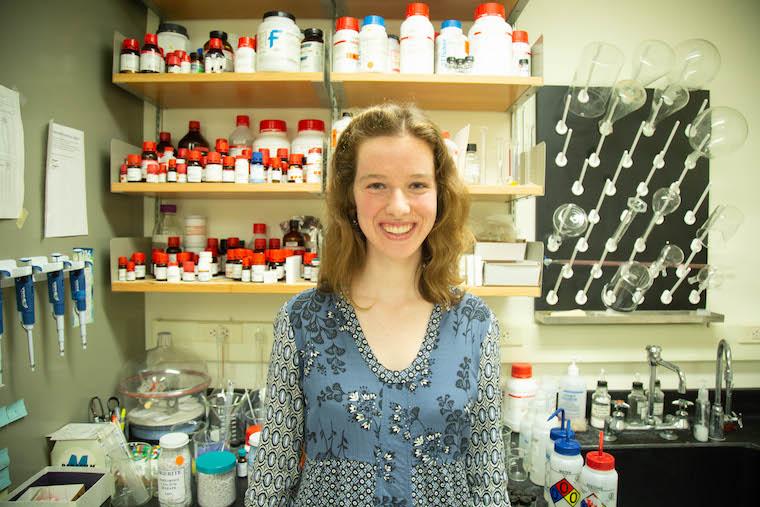Chemistry Major Jane Sedlak Receives 2019 Nexial Prize
May 21, 2019
Amanda Nagy

Fourth-year Jane Sedlak believes the fundamental principles of chemistry will help solve some of the most urgent societal problems, including climate change and air pollution. She also thinks a lot about the crossroads of chemistry and art—specifically, the chemistry of colors.
Sedlak’s deep interest in colors was sparked by a winter term trip to Indonesia her junior year. The group project, funded by the Luce Initiative on Asian Studies and led by Associate Professor of Ethnomusicology and Anthropology Jennifer Fraser, focused on sustainability and community responses to natural disasters. Sedlak was captivated by the traditional practice of making Batik dyes in the Kampung Batik Giriloyo, a Batik co-op outside of Yogyakarta, where she also discovered the effects of synthetic, mass-produced dyes on the environment.
“I think that colors are the intersection of art and science, and that fascinates me because it contains questions about perception and culture as well as lessons about preservation,” says Sedlak, a chemistry major with an impressive list of research experiences both on and off campus throughout her four years at Oberlin.
As the 2019 Nexial Prize winner, Sedlak will spend the next year studying stained glass conservation in Germany and England, as well as Batik dye creation in Indonesia. The $50,000 award is given annually to a graduating science student who has demonstrated both academic excellence and pursuit for cultural study.
Now in its third year, the Nexial Prize was created by an alumnus to recognize the contribution Oberlin’s liberal arts education made to his successful career as a scientist and manager, as well as his growth intellectually and culturally. The award emphasizes the value of a broad-based liberal arts education.
Through her year of exploration, Sedlak intends to learn more about balancing aesthetics and sustainability.
“Oberlin has taught me that building a science career to solve complex societal problems, such as air pollution, is like building a home,” she says. “In addition to a strong foundation in the fundamental sciences, it requires an exterior and windows to promote dialogues with other scientists, artists, historians, politicians, and the public. Studying the stories behind art will give me the chance to spark these dialogues.”
Sedlak will begin her studies at the Fraunhofer Institute in Wurzburg, Germany, whose chemists are leaders in the development of innovative ways to protect and restore pollution-damaged stained glass. She will also visit Lamberts Glass, the only manufacturer in Germany that still uses traditional methods to produce window glass.
From there, she will visit the York Minster Cathedral conservation workshop to learn how modern methods of conservation can be used to reverse the effects of air pollution. She has chosen York because the 15th-century stained glass windows are filled with intricately painted designs depicting kings and queens as well as whimsical cartoons, such as an angry puffed-up wren hunting a spider.
“These windows are messages from the past that I am keen to see and to learn how to save.”
She will spend the remainder of the year at the Kampung Batik Giriloyo co-op in Indonesia, where she will learn the traditional methods for making natural dyes and attempt to understand the factors that might motivate people to buy naturally-dyed Batiks instead of the less expensive synthetic-dyed materials.
A native of Berkeley, California, Sedlak has conducted independent research with Professor of Chemistry and Biochemistry Manish Mehta, and she will finish her honors research project in atmospheric chemistry with Matthew Elrod, professor of chemistry and biochemistry. She has presented her research at four professional conferences during her time at Oberlin.
Sedlak has also served as an Oberlin Workshop & Learning Sessions leader for organic and introductory chemistry for two years, and she was a writer, editor, and outreach coordinator for the Synapse, Oberlin’s student-run science magazine. She is a past recipient of the chemistry department’s Frank Fanning Jewett Award, and she is a member of the Sigma Xi and Phi Beta Kappa honors research societies.
Off campus, Sedlak has pursued summer research experiences at Hope College, Virginia Institute of Marine Science, and Woods Hole Oceanographic Institution.
After her year of exploration with the Nexial Prize, Sedlak will apply for doctoral programs in chemistry with the goal of teaching as a career. As she reflects on her Oberlin education, Sedlak says that without a liberal arts education, she would not have viewed challenging problems as having solutions that stem from a variety of different disciplines.
“My science professors taught me to see science outside of the classroom, and my humanities professors encouraged my interest in science by helping me research 17th-century optical principles of paintings and perception. I know that seeing the chemistry at play in the stories I love, from the fading glass wren and spider to bright batik dyes, will fuel my research and allow me to communicate the importance of saving these stories.”
Tags:
You may also like…
Oberlin Named Top Producer of Fulbright Students for 2024-25
February 25, 2025
Nineteen Oberlin College and Conservatory students and alumni were awarded Fulbright grants for the 2024-25 academic year, making the college the No. 1 producer of honorees among U.S. undergraduate-only institutions.
Oberlin Summer Research Institute Partners with Career Exploration and Development, Expands Capacity
January 17, 2025
For almost 20 years, Oberlin Summer Research Institute, or OSRI, has been fostering community and the development of Oberlin students. Now, beginning in summer 2025, the program will offer exciting new opportunities.
Making a Difference with Business
December 10, 2024
Omukoko Okoth ’25 chose Oberlin College for its values and opportunities, and in order to take advantage of all that Oberlin has to offer, he decided to participate in the business integrative concentration.


